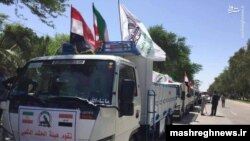The arrival of Iraqi Shiite militia Hashd al-Sha'bi in the flood-hit Khuzestan province in Iran has triggered angry reactions among Iranian social media users and also the ethnic Arabs in the Province.
This comes as new heavy rainfall and possible floods have been forecast for most parts of Iran in the coming days.
Iraj Masjedi, Iran's ambassador in Baghdad told Iranian news agencies on Saturday April 13 that Hashd al-Sha'bi forces have been deployed to Khuzestan to help with flood relief.
Masjedi said hundreds of Iraqi militia, including 200 on Friday, have arrived in Iran to help the flood-hit people in Khuzestan and Lorestan provinces in western Iran.
A video widely shared on social media shows an angry ethnic Arab resident in Khuzestan protesting the arrival of Hashd al-Sha'bi.
Hashd al-Sha'bi, a militia set up by the IRGC's Qods Force in Iraq to fight Takfiri Sunnis, says its engineering units and heavy machinery are in Khuzestan to block the flow of floodwater into Iraq. The militia's statement was published on Alsumaria's Twitter.
Nevertheless, Iranians on social media condemned its presence in Iran as "a disgrace".
Others have warned that the Iraqi militia backed by Qods Force, may be in Khuzestan to suppress possible unrest.
On Friday, protests broke out in the Ahvaz the capital of the province by residents who are angry at the government’s handling of the flood disaster and reports that water was not being diverted to marshlands for fear of damaging nearby oil facilities.
The Iranian Cyber Police says 24 social media users have been arrested in Khuzestan on charges of spreading rumors about the situation. This comes while traditional media in Iran have acknowledged that real news dissemination about floods takes place mainly on social media.
Iranian state TV has been widely criticized by other media for broadcasting the views and claims of officials about their contribution to relief efforts rather than reflecting people's problems.
Meanwhile, the Iranian Meteorological Organization (IRIMO) has forecast heavy rainfall and issued flood warnings in the south, southwest and northeast, as well as Sistan-Baluchestan, Khorasan, Isfahan, Yazd and Kerman provinces for Saturday and Sunday.
Rivers might burst their banks in Khorasan region provinces, warned the IRIMO.
In the meantime, the ministers of the Interior, Energy, Roads, and Agriculture will brief the Iranian Parliament (Majles) on the situation on Sunday, reported the parliament’s news agency (ICANA).
The heads of the IRIMO and Crisis Management Organization are also going to report to the Majles on Sunday.
Meanwhile, reports from Lorestan province say part of Pol-e-Dokhtar and 8 surrounding villages do not have fresh water supply for close to two weeks while roads to 167 villages have been damaged and 69 villages are experiencing power cuts.
In another development, the managing director of Iranian Railways says the tracks linking Iran's southern ports to the north have been damaged by floods in Golestan, Khuzestan and Lorestan provinces, adding that rail replacement transportation has been in place for facilitating the shipment of imported steel among other commodities.
The official said that rail network in the other parts of the country is operating normally.
Other officials have estimated the damages caused by flood at 30 trillion rials or around $6 billion based on the official exchange rate; $2.2 billion based on free market rate.
Meanwhile, Iran's medical emergency services have reported that at least 77 people have lost their lives in the floods as of April 13.




